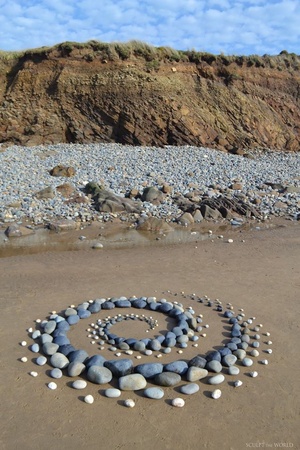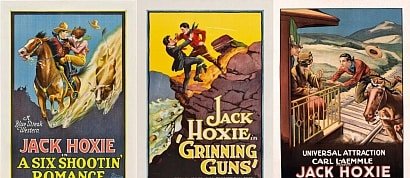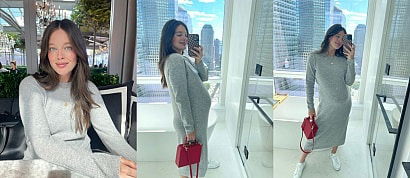The Ephemeral Art of Jon Foreman (Land Artist)
Artist Jon Foreman is a creator of various styles of ‘Land Art’. His practice, which he calls Sculpt the World, showcases rocks and found objects fashioned into mesmerizing patterns and compositions. He felt that the natural world had more in it to be explored. Most of Jon Foreman’s work takes place in the coasts of Pembrokeshire, Wales, where he particularly lives.
His work is ephemeral in many differing ways; Most often the weather and immediate climate will make his work disappear (be blown down/washed away by the tide), and sometimes other people will interfere. This is all part of the creative process and has proven to benefit his work.
Be it with stones or leaves, inland or on beaches. He has even created works in derelict environments using materials such as broken glass or ashes and general debris. The scale of his work varies massively; he may use stones or driftwood to make something small and minimal. Otherwise he may be seen drawing massive scale sand drawings up to 50 metres across.
Jon’s practice is not just something he enjoys but it is also a therapy for him, an escape from the stresses of everyday life.
“Repeat processes are always very therapeutic and this is a good example of that, getting lost in the process is an important part of land art,” Foreman says.
Jon began his journey making Land Art/Sculpture while in college but he feels his creative play with materials and innovative ideas are something which started long before. Having grown in Pembrokeshire, he saw the beauty of the coastline and woodlands and made use of them by collaborating with nature itself.
Arranging with stone has shown Foreman some of its unexpected qualities. He’s noticed that rock, despite its solidity, changes when grouped together; they become “malleable,” Foreman reveals. “There are so many ways of working with stone; the color, the size, the shape the angle it is placed, the direction it faces, endless possibilities. Although stone isn't my only material of choice, it is currently my favorite as it presents so many different opportunities.”
Land art is ephemeral and will eventually be reclaimed by the earth from which it came. “It often becomes a race towards the end as the waves draw closer,” Foreman says. “I try to stay to see the work get erased and capture the moment of impact.” It could be a poignant time, but Foreman chooses to see the beauty in his work's short lifespan. “I create using material that is made from that environment for that environment. The tide washes it all back to the tide line, and I come back the next day with an empty canvas to work with. People often ask if it bothers me that the work has to disappear eventually. To that, I say: not at all. If anything the fact that it's short-lived makes it more special to me.”
Land artist Jon Foreman finds comfort in arranging stones in eye-pleasing formations on the beach. His practice, which he calls Sculpt the World, showcases rocks fashioned into swirling patterns as well as giant circles containing an array of rainbow-esque hues. “This process is therapy to me,” Foreman tells. “The simple act of placing stone upon stone in the sand is very therapeutic. I'm sure we all enjoy a walk on the beach but this process I find to be more immersive; being there in nature, losing myself in the work, having left behind all the stresses of day to day life.”
His work is ephemeral in many differing ways; Most often the weather and immediate climate will make his work disappear (be blown down/washed away by the tide), and sometimes other people will interfere. This is all part of the creative process and has proven to benefit his work.
Be it with stones or leaves, inland or on beaches. He has even created works in derelict environments using materials such as broken glass or ashes and general debris. The scale of his work varies massively; he may use stones or driftwood to make something small and minimal. Otherwise he may be seen drawing massive scale sand drawings up to 50 metres across.
Jon’s practice is not just something he enjoys but it is also a therapy for him, an escape from the stresses of everyday life.
“Repeat processes are always very therapeutic and this is a good example of that, getting lost in the process is an important part of land art,” Foreman says.
Jon began his journey making Land Art/Sculpture while in college but he feels his creative play with materials and innovative ideas are something which started long before. Having grown in Pembrokeshire, he saw the beauty of the coastline and woodlands and made use of them by collaborating with nature itself.
Arranging with stone has shown Foreman some of its unexpected qualities. He’s noticed that rock, despite its solidity, changes when grouped together; they become “malleable,” Foreman reveals. “There are so many ways of working with stone; the color, the size, the shape the angle it is placed, the direction it faces, endless possibilities. Although stone isn't my only material of choice, it is currently my favorite as it presents so many different opportunities.”
Land art is ephemeral and will eventually be reclaimed by the earth from which it came. “It often becomes a race towards the end as the waves draw closer,” Foreman says. “I try to stay to see the work get erased and capture the moment of impact.” It could be a poignant time, but Foreman chooses to see the beauty in his work's short lifespan. “I create using material that is made from that environment for that environment. The tide washes it all back to the tide line, and I come back the next day with an empty canvas to work with. People often ask if it bothers me that the work has to disappear eventually. To that, I say: not at all. If anything the fact that it's short-lived makes it more special to me.”
Land artist Jon Foreman finds comfort in arranging stones in eye-pleasing formations on the beach. His practice, which he calls Sculpt the World, showcases rocks fashioned into swirling patterns as well as giant circles containing an array of rainbow-esque hues. “This process is therapy to me,” Foreman tells. “The simple act of placing stone upon stone in the sand is very therapeutic. I'm sure we all enjoy a walk on the beach but this process I find to be more immersive; being there in nature, losing myself in the work, having left behind all the stresses of day to day life.”
Added to
People who voted for this also voted for
Western Movie Posters: Jack Hoxie
Top 10 Movie Logos
My Top 10 Films From 1985
Bond Girls Top10
Time Travel
-Amaze Emily Didonato 2021!-
Adorable Maki Horikita
Time Travel Live-Action Series
Domenica delle Palme
Giovedì Santo - Ultima Cena di Gesù
Pasqua di Risurrezione
San Marco evangelista
Santissima Trinità
Beata Vergine Maria Regina
Sacratissimo Cuore di Gesù
More lists from James OK
Comtesse Monique
Charlie Chaplin Quotes
Decadent desserts : good for the mood
Hundred Dragons Elevator : Bailong Elevator
The Chiba Urban Monorail in Japan
Trapped in Tradition
Turkish Ice Cream Prank
 Login
Login




























































